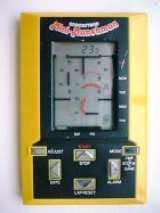
Mini-Munchman
Encyclopedia
Mini-Munchman is a handheld electronic game
that was released in 1981 in the UK by Grandstand
. The game is a rebadged version of Epoch-Man from Epoch
.
s Pac-Man
, the game was released in the same year as Grandstand's larger Munchman
game and in the same yellow colour scheme (Conversely, Epoch Man is white). Mini-Munchman however is a pocket-sized device including additional features such as real time clock, alarm and stopwatch. The game later spawned a larger LCD version with greater screen area called Pocket Pac-Man.
or equivalent cells. In-game objects are displayed on fixed, immovable LCD elements. The main score display (which doubles up as a date/time and stopwatch display) consists of a three-and-a-half digit display and an extra small digit for tenths of a second, or lives remaining.
clones, the object of the game is to move a Pac-Man type character around a maze, eating all the dots and avoiding ghosts. However, in this version, the dots are replaced with fruit items and there is also the addition of two humpback bridges which contain a fruit item both over and underneath the bridge. Successive levels are faster, eventually becoming very fast to play. Experienced players (after some practice) can eventually work out a fixed route which can guarantee completion of each level without losing a life. Because of the limits of the fixed numeric diplay, the highest score that can be represented is 1,999. Once this is exceeded, the score displays HHH and the game can be considered won. The ultimate achievement which cannot be bettered is to score HHH with a maximum of six lives remaining.
Handheld electronic game
----Handheld electronic games are very small, portable devices for playing interactive electronic games, often miniaturized versions of video games. The controls, display and speakers are all part of a single unit. Rather than a general-purpose screen made up of a grid of small pixels, they...
that was released in 1981 in the UK by Grandstand
Grandstand (game manufacturer)
Grandstand was a video game console and electronic game manufacturer and distributor. It was based in the United Kingdom and New Zealand and was active in the 1970s and 1980s.-Overview:...
. The game is a rebadged version of Epoch-Man from Epoch
Epoch Co.
Epoch Co., Ltd. is a Japanese toy and computer games company founded in 1958 which is best known for manufacturing Barcode Battler and Doraemon video games...
.
Overview
Capitalising on the then-contemporary success of NamcoNamco
is a Japanese corporation best known as a former video game developer and publisher. Following a merger with Bandai in September 2005, the two companies' game production assets were spun off into Namco Bandai Games on March 31, 2006. Namco Ltd. was re-established to continue domestic operation of...
s Pac-Man
Pac-Man
is an arcade game developed by Namco and licensed for distribution in the United States by Midway, first released in Japan on May 22, 1980. Immensely popular from its original release to the present day, Pac-Man is considered one of the classics of the medium, virtually synonymous with video games,...
, the game was released in the same year as Grandstand's larger Munchman
Munchman (tabletop electronic game)
Munchman is a tabletop electronic game that was released under license in 1981 in the UK by Grandstand. It is a rebadged version of the Tomy game known as Pac Man in the US and Puck Man in Japan.-Overview:...
game and in the same yellow colour scheme (Conversely, Epoch Man is white). Mini-Munchman however is a pocket-sized device including additional features such as real time clock, alarm and stopwatch. The game later spawned a larger LCD version with greater screen area called Pocket Pac-Man.
Hardware
The game employs a low consumption LCD-based screen, allowing for a small form factor design incorporating alkaline button power cells. The game requires two LR-44LR44 battery
LR44 is the IEC designation for an alkaline 1.5 volt button cell, commonly used in small LED flashlights, digital thermometers, calculators, calipers, watches, clocks, toys and laser pointers....
or equivalent cells. In-game objects are displayed on fixed, immovable LCD elements. The main score display (which doubles up as a date/time and stopwatch display) consists of a three-and-a-half digit display and an extra small digit for tenths of a second, or lives remaining.
Gameplay
Like most Pac-ManPac-Man
is an arcade game developed by Namco and licensed for distribution in the United States by Midway, first released in Japan on May 22, 1980. Immensely popular from its original release to the present day, Pac-Man is considered one of the classics of the medium, virtually synonymous with video games,...
clones, the object of the game is to move a Pac-Man type character around a maze, eating all the dots and avoiding ghosts. However, in this version, the dots are replaced with fruit items and there is also the addition of two humpback bridges which contain a fruit item both over and underneath the bridge. Successive levels are faster, eventually becoming very fast to play. Experienced players (after some practice) can eventually work out a fixed route which can guarantee completion of each level without losing a life. Because of the limits of the fixed numeric diplay, the highest score that can be represented is 1,999. Once this is exceeded, the score displays HHH and the game can be considered won. The ultimate achievement which cannot be bettered is to score HHH with a maximum of six lives remaining.

